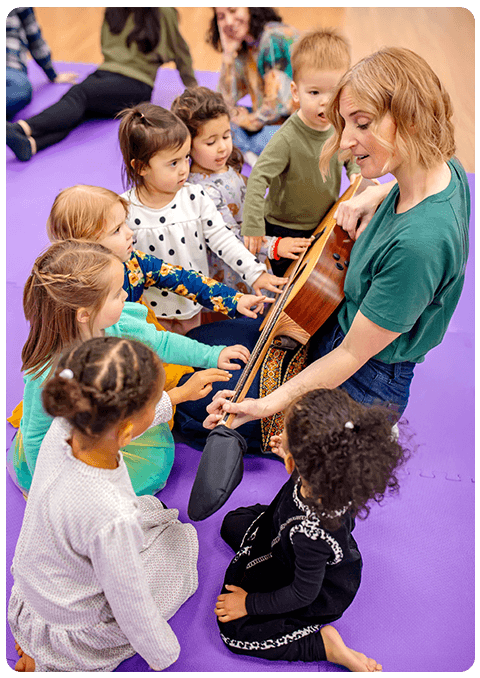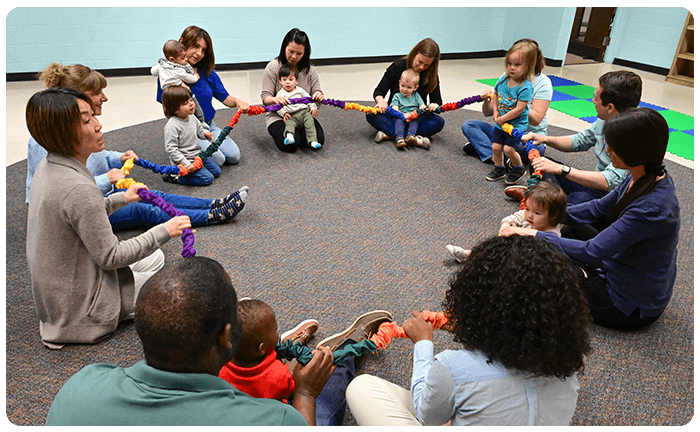Carol Ann Blank, Ph.D., MT-BC
Manager of Research and Inclusion Support Services, Music Together Worldwide
Music Together® classes are microcosms of our communities, so whether your child is neurotypical or neurodiverse, our community includes you! Music Together strives to offer inclusive music-making experiences that all families can enjoy with their children. That is why we welcome neurodiverse learners who bring their authentic selves to our classrooms. Is your child an expert in a niche topic and will tell us everything they know about it at every opportunity? Does your child express delight in their loudest voice? We are here for all of it!

Since our curriculum supports children’s development, Music Together teachers have no expectations of performance. Instead, we welcome all forms of children’s response to music and recognize that each child’s contribution enriches our class. We encourage families who have a child with a disability to contact their local Music Together center to discuss their particular concerns or need for accommodation. Teachers appreciate knowing that there may be communication differences, or that a child may become overwhelmed by sounds.
While some of our teachers have training, knowledge, or experience in inclusive practices, all of our teachers have access to resources to help them make music accessible to the families in their classes. Over the years, we’ve heard from many parents that the realization that their whole family is accepted and included in every facet of music-making, just as they are, is a powerful one.
What does the research say about using music with neurodiverse early learners?
In light of relevant research, we can provide parents with the information they need to fully appreciate their child’s development. For instance, research suggests that music-making with one’s neurodiverse learner can support social engagement. In a study by Grace Thompson, parents who participated with their child in music-play sessions reported “perceived high levels of child enjoyment, mutual enjoyment, and described using music-play strategies in the home environment.” Neurodiverse preschoolers exhibited more engagement in book reading with their parents when the books were song-based rather than picture-based (such as the family songbooks Music Together provides each semester). The research highlights “how musical contexts impact the behavior of both partners in the interaction.”
Music activities are excellent vehicles for auditory, motor, and emotional development because music activates the whole brain. Receptive (e.g., listening to promote relaxation or sleep) and expressive experiences of music (e.g., music play, instrument exploration, movement to music, singing, etc.) engage the brain AND lead to self-regulation, co-regulation with peers or loved ones, and feeling connected to others. That’s why the involvement of loving adults in all aspects of music engagement in Music Together classes is key for neurodiverse early learners.

How has Music Together put this knowledge into practice?
To enrich our teaching practices, Music Together drew on knowledge from those who work with neurodiverse learners and their families. We convened a workgroup of Music Together teachers and licensees, special education teachers, and music therapists, and they developed a model that provides all teachers with basic information on a variety of disabilities and suggested approaches to increase accessibility and promote children’s engagement in active music-making in our family and in-school classes.
Music Together family classes are wonderfully inclusive experiences but they are not clinically-oriented. Music Together Within Therapy is another way we support neurodiverse children. It is a license type for clinicians who wish to intentionally include music in their practice to support the development of the children and families they serve. Families who wish to receive more specialized, individualized attention may wish to look for a Within Therapy provider.
How can we experience neurodiverse learners in Music Together classes?
Neurodiverse learners bring their curiosity, fragility, and resilience to the music-making experience, and Music Together teachers are there to joyfully witness these gifts. Some children are more inclined to show us what they know in ways we can understand. Sometimes, however, neurodiverse learners bring us the opportunity to increase our understanding of musical behaviors. We have come to reevaluate what it means to be musical beyond the ability to move to a beat (rhythm development) or the ability to recognize differences in pitch (tonal development). Although the science and art of early childhood music-learning has made some great strides, and Music Together has certainly been a leader in the inclusive music-making arena, we still have a lot to discover. We are all learning together.
All in all, Music Together classes can be a fantastic way for you and your children (neurotypical or neurodiverse) to engage in music and make friends in your community. If your child is neurodiverse, be sure to establish an open and collaborative conversation with your Music Together teacher. Ask for the accommodations your child needs, but remember to sing along and have fun yourself. Playing your Music Together songs and looking at the family songbook together at home helps to facilitate the transition to classes and enhances the enjoyment of reading and singing. Contact your local Music Together center to schedule a class visit. We look forward to welcoming you to our global community of music-makers!
Carol Ann Blank, PhD, MT-BC is the Manager of Research and Inclusion Support Services for Music Together LLC. Dr. Blank supports Music Together licensees and registered teachers who work with children who have disabilities to promote access to music-making. Contact Dr. Blank at cblank@musictogether.com.
References
Budson, A. E., (2020). Why is music good for the brain? Harvard Health Blog. Harvard Health Publishing. Harvard Medical School. https://www.health.harvard.edu/blog/why-is-music-good-for-the-brain-2020100721062
Liu, T., Schultz, B. G., Dai, D., Liu, C., Lense, M. D., (2021). Parent-child nonverbal engagement during spoken versus sung book-sharing in preschoolers with and without autism. Psychology of Music Volume 50, Issue 6. https://doi.org/10.1177/03057356211058781
Thompson, G., Shanahan, E. C., Gordon, I., (2018). The role of music-based parent-child play activities in supporting social engagement with children on the autism spectrum: A content analysis of parent interviews. Nordic Journal of Music Therapy Volume 28, 2019 – Issue 2, 108-130. https://doi.org/10.1080/08098131.2018.1509107



